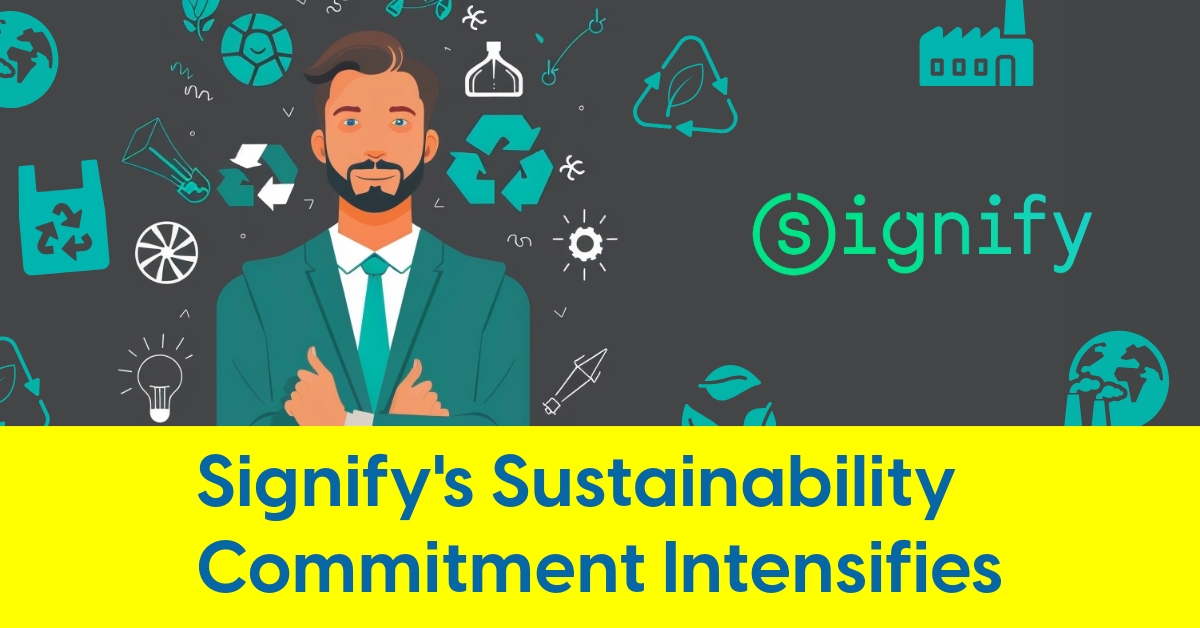April 18, 2024
Signify's Sustainability Commitment Intensifies

Company applies self-imposed pressure to transform operations sustainably and profitably, without carbon offsets
Netherlands-based Signify, the world's largest lighting company, has made sustainability a core element of its corporate identity, often communicating its green initiatives and accomplishments through press releases. Today's announcement, its fourth on the topic of sustainability in the last four months, is particularly noteworthy as it emphasizes significant achievements and sets ambitious goals for even more aggressive climate action.
Signify is voluntarily setting a high bar for itself by attaching a high degree of difficulty to these ambitious goals — doing so without carbon offsets — all while meeting the profitability goals demanded by the shareholders of this $7+ billion company.
Signify has outlined its plans to profoundly and positively impact its environmental footprint. It has set forth a roadmap to drastically reduce emissions across its entire global operation, emphasizing a future without reliance on carbon credits. This announcement not only reaffirms Signify's commitment to environmental stewardship but also may position it among the frontrunners in the global effort to combat climate change.
Here are some of the main takeaways:
Ambitious Net Zero Targets: Signify commits to reaching net-zero greenhouse gas emissions by 2040 across the value chain. This goal encompasses scope 1, 2, and 3 emissions, demonstrating a comprehensive approach to tackling all aspects of their carbon footprint.
Validation by Science Based Targets initiative (SBTi): The company's targets have been reviewed and validated by the SBTi, ensuring they are scientifically grounded and aligned with global efforts to limit warming to 1.5°C. This adds credibility to their claims and underscores their commitment to rigorous, measurable environmental standards.
Significant Reduction Achievements: The company has already achieved a 50% reduction in emissions since 2019 and exceeded its 2025 targets ahead of schedule. This demonstrates effective implementation of their strategies and provides a solid track record of progress, which bolsters confidence in their ability to meet future targets.
Why is this significant?
Signify's recent disclosures reveal a comprehensive strategy in its pursuit of sustainability, marked by significant progress in reducing emissions across all scopes of its operations. The company's achievements are particularly impressive with a 50% reduction in absolute scope 1 and 2 greenhouse gas (GHG) emissions since 2019, from a baseline year of 2010.
Furthermore, Signify's commitment extends beyond its immediate operations to encompass scope 3 emissions, which include indirect emissions from activities such as procurement, manufacturing, and disposal. This is indicative of a thorough approach to sustainability, considering the entire lifecycle of their products and services.
A key element of Signify is also applying sustainability pressure to its suppliers with the CDP Supply Chain program, an initiative that influences and facilitates emission reductions throughout its supply chain. By actively participating in this program, Signify not only applies pressure but also provides support to its suppliers to set and achieve their own science-based targets.
Additionally, Signify's targets and their alignment with the Science Based Targets initiative (SBTi) add a layer of credibility to their commitments. The SBTi is a partnership involving respected organizations like the World Resources Institute and the World Wide Fund for Nature. It helps companies set realistic greenhouse gas reduction targets based on the latest climate science, ensuring their plans are robust enough to meet international goals for limiting global warming. When SBTi validates a company's climate targets, it aims to confirm these goals are scientifically sound.
How will Signify achieve these aggressive goals?
While Signify's strategies are commendable, several areas warrant closer examination.
The company's goal to achieve a 90% reduction in emissions by 2040 without the use of carbon credits is particularly ambitious. This target sets a high bar, raising questions about the practicality and the technological advances needed to reach such a significant decrease in emissions. Without relying on carbon offsets, which can often help bridge the gap in reduction efforts, Signify must rely entirely on direct reductions through technological innovations and changes in business practices.
The answers to these questions may lie in the forthcoming "Detailed Climate Transition Plan", which Signify plans to unveil sometime in 2024. This will seemingly provide further insights into understanding how the company intends to meet these targets.
Part of the balancing act of sustainability priorities at a publicly traded multi-billion dollar company is implementing these measures with little to no effect on operational costs and, consequently, professional and consumer prices. It also involves how the company will maintain operational efficiency and profitability amidst such transformative changes. These elements are essential for assessing the feasibility and overall impact of Signify's long-term sustainability commitments.










